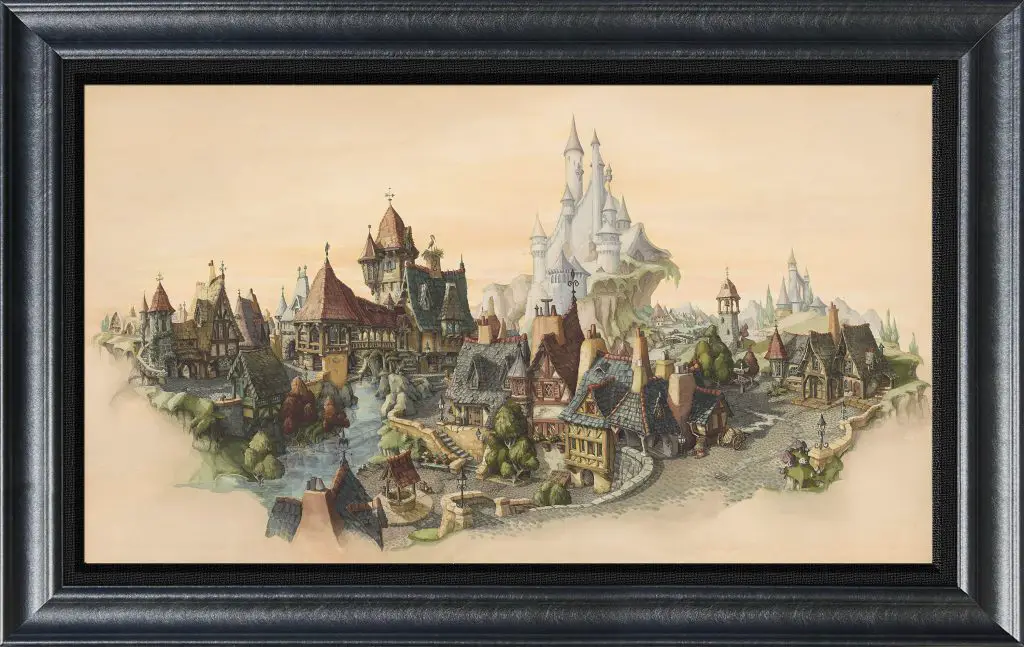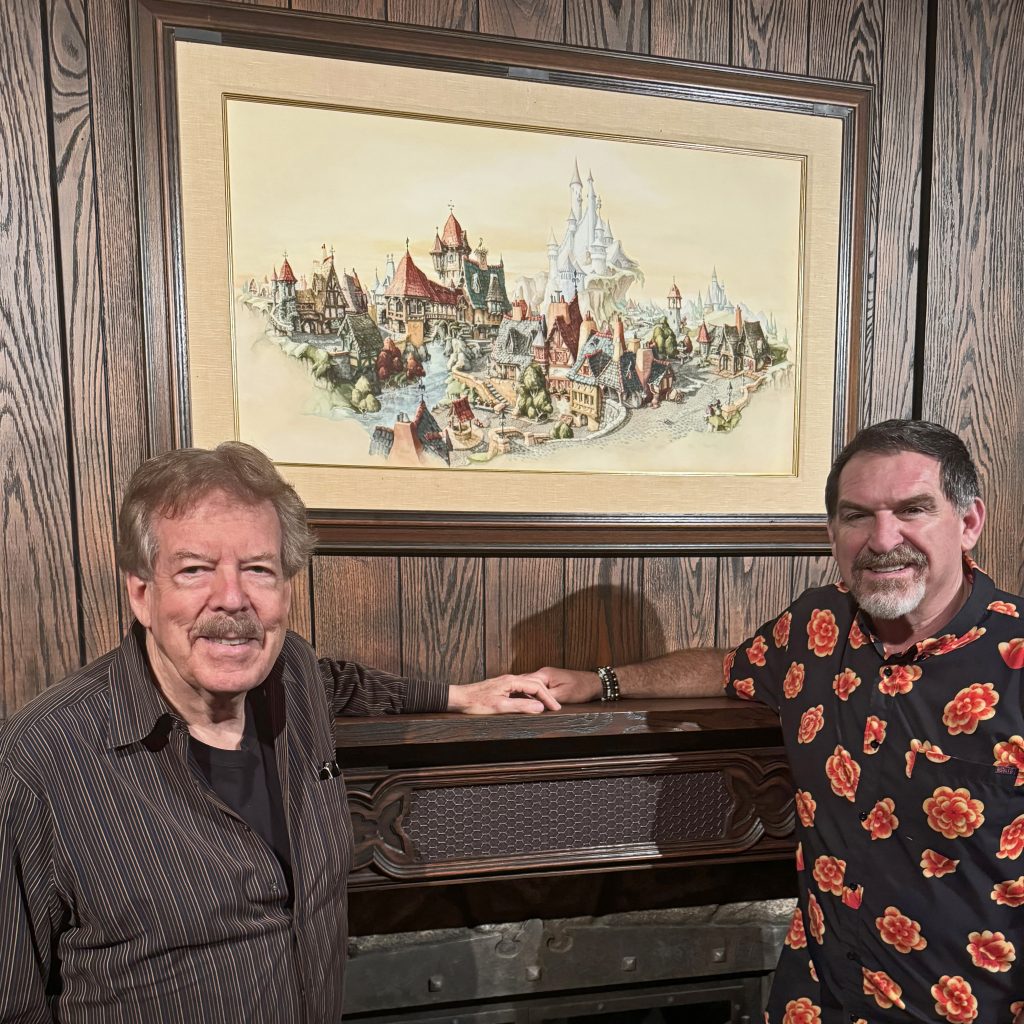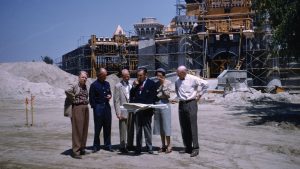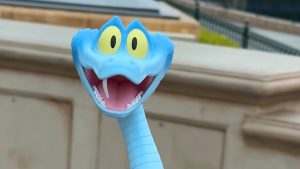Disney fans worldwide know Tony Baxter as a Disney Legend and former Imagineer. He also is an incredible artist. Earlier this year, Disney Fine Art released Baxter’s Steps of St. Paul’s. The next piece that is being released is called Tyrolean Fantasy. Inspired by the style of Pinocchio, Tony Baxter created this beautiful piece when working at Walt Disney Imagineering. The backgrounds for this Disney masterpiece were created by Claude Coats, who became a mentor and friend to Baxter.

Recently, Michael Young (CEO of Disney Fine Art, published by Collectors Editions and officially licensed by Disney) visited Tony Baxter at his home to talk about Tyrolean Fantasy, Claude Coats, and more. Read this interview below and then check out Tyrolean Fantasy on the Disney Fine Art website!

MICHAEL YOUNG
Tony, when did this artwork, which we’re calling “Tyrolean Fantasy,” come about, and why?
TONY BAXTER
Well, that’s a bit of a long story. I was transitioning from getting my college degree and moving from working with my college mentor, Dr. Maxine Merlino, to landing a role at Walt Disney Imagineering in the model shop and beginning to work with various fellow Imagineers.
Not long after arriving at WDI, I quickly developed a friendship with Claude Coats, a future Disney Legend and one of the original Imagineers. He soon became another valued mentor of mine.
I’ve always said that mentoring is a two-way street. Claude was as interested in my previous experience as an attraction host at Disneyland, in terms of the attractions he had designed and how people reacted to them, as I was in how he did the amazing things he had done in his career.
M. YOUNG
What would we know that Claude worked on?
T. BAXTER
When I met Claude, he had worked at the Walt Disney Studios and WDI for nearly 40 years. He started in the background department at the studios in 1935. Through the years, Claude worked on so many Walt Disney animated features that are now considered classics or masterpieces such as Snow White and the Seven Dwarfs, Pinocchio, Fantasia, Dumbo, Saludos Amigos, Victory Through Air Power, The Three Caballeros, Make Mine Music, Melody Time, Song of the South, The Adventures of Ichabod and Mr. Toad, Fun and Fancy Free, Cinderella, Alice in Wonderland, Peter Pan, and Lady and the Tramp.
At Imagineering, Claude contributed significantly to popular shows and attractions such as Haunted Mansion, Pirates of the Caribbean, Mr. Toad’s Wild Ride, Snow White’s Scary Adventures, and Submarine Voyage, among others. Claude also contributed to the 1964-65 New York World’s Fair attractions, including Magic Skyway, Carousel of Progress, and it’s a small world, plus the Mickey Mouse Revue at Walt Disney World and numerous attractions for Epcot Center, including Universe of Energy, World of Motion, Horizons, and several World Showcase pavilions.
M. YOUNG
So, from Claude’s impressive resume, one film piqued your interest, right?
T. BAXTER
Yes. Although Claude had an incredible career in animation and Imagineering, the high watermark of his career for me is the incredible backgrounds he created for Walt Disney’s animated feature Pinocchio in 1940. They’re exquisite. It is remarkable, from the detailed close-up of melting wax on a candle to Geppetto’s fanciful workshop, which is full of clocks and gilding. The film is considered the most technically perfect hand-drawn animated feature of all time, and I know Claude’s beautiful backgrounds, which contribute so much to the look of the film, help justify that claim.
M. YOUNG
The village in “Tyrolean Fantasy” looks familiar, as if I’ve been there before.
T. BAXTER
I hope it looks familiar because you have been there! In the early 1980s, when creating a New Fantasyland for Disneyland in California, the team and I wanted to get what Claude had done visually in two dimensions in Pinocchio and successfully infuse that sense of fantasy into the three-dimensional environment of a revitalized Fantasyland.
However, going back about five years to the mid-1970s, I thought, I would lean on all that experience and know-how that Claude possessed to learn how to capture that kind of fantasy in two dimensions in a painting.
And so, I was working with Claude, and I mentioned that I’d like to paint something in the style of a background from Pinocchio. He laughed and said, ‘Do you know how hard that will be?’ And I replied, ‘Probably, but I have to feel like I did it.’ He was right. It took me about six weeks to complete what we’re calling ‘Tyrolean Fantasy’ today (back then, I didn’t even have a name for it). I did it all on my own time at home after work.
I was almost hesitant to bring the finished piece into Imagineering because I didn’t want Claude to point out what was wrong with it. It wasn’t easy to do. I used watercolor, so whatever is white in the painting is actually the raw paper. From the beginning, you must be careful about what must stay white.
In composing the artwork, I wanted to send the castle part back, so I had to limit my palette. I learned these things from Claude’s background paintings in Pinocchio and Eyvind Earle’s work on Sleeping Beauty; the depth is created by reducing the contrast in the back portions of the painting and concentrating it in the front.
Now, when I look at it today, there are things I would have done differently, but I’m excited about it because it marked two significant milestones in my career. The first was when I had it hanging over my desk; almost everyone in Imagineering management would walk by.
So, when it came time to think about redoing Disneyland’s Fantasyland in the early 1980s, management said, ‘What about that young guy out in the model shop who has that painting hanging in his office? Maybe we should give him a shot at redoing Fantasyland; he seems to get it.” When the opportunity arose to redo Fantasyland, the painting hanging over my desk gave me an edge on that project.
M.YOUNG
Aside from the New Fantasyland that opened in May of 1983 at Disneyland in California, something else also looks familiar.
T. BAXTER
You’re right; there is, especially if you’ve been to Disneyland Paris. That’s the second milestone this painting helped create.
In the early 1990s, while designing the park in Paris, we tried to figure out how to bring a castle to France and Europe, where castles are everywhere. What could we do that’s different?
The castles in the Disney animated features Snow White, Cinderella, and Sleeping Beauty all had hillsides, just like the castle in my painting. However, in most of our parks, the castles are on the ground for practical reasons, such as easier truck access and maintenance.
I wanted to see if we could build something on a hill. I revisited this painting, printed it out, took it in, and explained to the team that whatever we do with this castle must allow trucks through the front entrance yet appear to everyone as though it’s situated on a hill. “Tyrolean Fantasy” was the reference to illustrate what I meant by that.
M. YOUNG
The castle focal point in “Tyrolean Fantasy” looks very reminiscent of the castle at the end of Snow White, especially with the color palette behind it. Is that accurate?
T. BAXTER
Yes, I think so. There’s the Snow White castle, but there’s also a great deal of influence from the famous multi-plane camera pan through the village in Pinocchio.
M. YOUNG
And what did Claude Coats think of the final artwork as we see it today? What was his reaction?
T. BAXTER
First, Claude had years of experience and was a far better artist than me. When you look at it, you might say I came close. However, he was never negative and would never say anything critical. It wasn’t a reaction of astonishment because here was someone who could and did achieve greatness and was renowned for doing so.
For instance, I’ve looked at the violin painting with Jiminy Cricket on it in Pinocchio that Claude created—it looks like a Stradivarius, and it’s just beautiful. The candle with the wax is so transparent, and all that detail is something I could never do, even now.
So, for me, I was thrilled with it, and I think he really admired that I stuck with it. It wasn’t an assignment for Disney; it was something I needed to express, to prove to myself that I could do it if I chose to. And, of course, I have never done anything like that again. It was a one-time thing. However, the original hangs over my fireplace in my den, reminding me that I did it!
M. YOUNG
Was painting a means to an end with you?
T. BAXTER
No. Not necessarily because it was a way to convey an idea.
In college, we all painted; we got our Grumbacher Brushes, paper, and all that stuff. It was all about physical media in the sense of the art form. There was no other way to convey an idea except by painting or building models, which is something I learned once I joined Imagineering.
As a kid, I had train layouts and all the usual stuff kids had back then. I even built a miniature treehouse based on the Disneyland treehouse and a model of the Disneyland castle for my summer projects each year—I would come up with something new. Students now coming out of school today need to have a different set of tools. They must be proficient in AI and digital rendering, among other things.
M. YOUNG
How do you feel about having “Tyrolean Fantasy” reproduced as a Disney Fine Art limited edition and knowing it will reside in homes worldwide?
T. BAXTER
It’s actually a pretty great feeling because I hope this piece of art will be a gateway for people to learn more about the wonderful person that was Claude Coats. In my mind, Claude should be at the forefront of Disney Legends!
We love so many of the classic animated features, but Claude’s skillful talents as an artist helped create the wonderful visual world in which those stories took place.
The same is true of Imagineering. Everyone remembers the Pirates in the Caribbean, but Claude’s set designs and layouts created that particular Spanish Main. The Haunted Mansion and many other classic attractions are the same.
It’s also humbling to know that someone will have a strong kinship with the piece, so much so that they will want to feature “Tyrolean Fantasy” in their home. If they place it over the fireplace as I have it, that will genuine connection and we’ll share in our affinity for the artwork.
What do you think about this interview? What do you think about Tyrolean Fantasy? Will you be adding this beautiful piece of art to your collection? Share your thoughts and opinions in the comments below!






